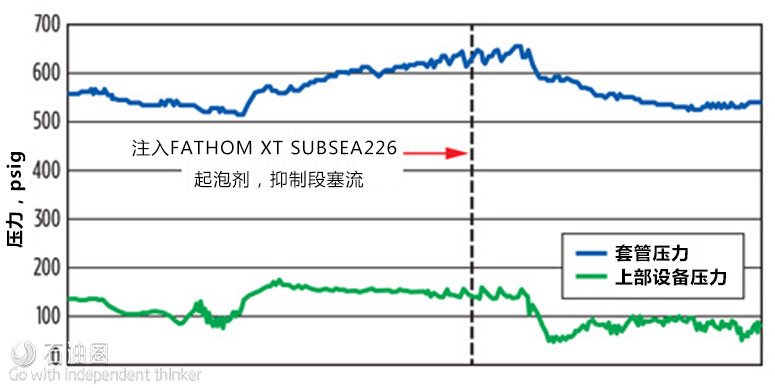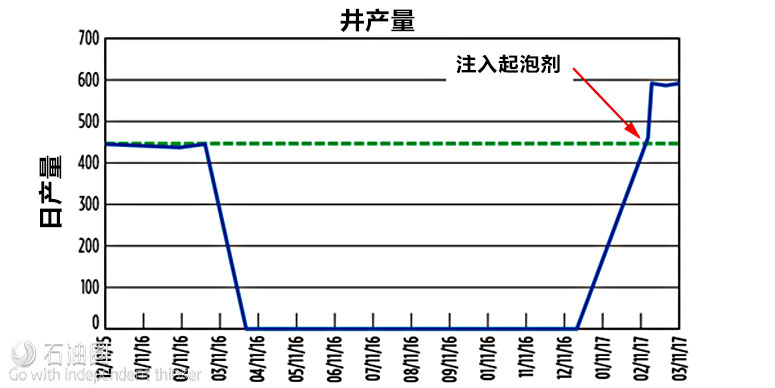SUBSEA-CERTIFIED FOAMER
This comprehensive screening process guided the development of a new FATHOM XT SUBSEA black oil foamer, an oil-soluble technology designed to foam crude oil containing up to 60% water. The product can be used on either a batch or continuous basis, depending on the nature and severity of the crude oil loading problem and the ultimate treatment objectives. Typical batch dosage is between 30,000 and 150,000 ppm, based on the fluid volume in the well. When applied continuously, dosages are typically 500 to 5,000 ppm, based on total fluids production.
The product can be added directly to the well without prior dilution. In addition to enhancing production of liquid-loaded oil wells, the foamer can be used to restart production of shut-in wells and shows a wide temperature stability range. It may be stored at temperatures as low as –45°F, and is approved for capillary string applications in temperatures up to 200°F.
PROVEN PERFORMANCE
The black oil foamer has been used to boost oil production rates, reduce slugging and extend well flow in a number of deepwater wells since its initial development. One deepwater operator in the Gulf of Mexico experienced intermittent flow in a subsea well, due to low reservoir pressure and liquid loading issues. The well, a 2-mi subsea tieback in 3,500 ft of water, was shut in for extended periods of time—typically six months—to allow sufficient time for pressure to build up to unload the tubing and flowline.
After this period, the well was brought back into production, but pressure quickly dropped, such that the well only produced for approximately two weeks before it had to be shut in again for another six months. To solve the issue, the operator asked Baker Hughes for an alternative solution that would help reduce downtime and increase production.
The service provider recommended FATHOM XT SUBSEA black oil foamer as the solution. Multiple field trials conducted in the Gulf of Mexico indicated that the product would not produce any issues with respect to oil/water separation and produced water discharge.
The foamer was applied through an umbilical to the subsea tieback. After an initial batch treatment and subsequent continuous treatment, the well began to produce fluid, and the tubing pressure soon stabilized. At this point, the operator decided to shut off the foamer and monitor the results.
The well produced with no foamer for a short period of time, until the tubing pressure began to fluctuate, and slugging was observed in the flowline and riser. The continuous injection of black oil foamer then resumed, and the dosage was optimized to a point where slugging was mitigated and pressures stabilized, Fig. 2. The well flowed for two months with the continuous black oil foamer treatment, until it was shut in at the customer’s discretion.
The foamer application also improved the production cycle for the well from two weeks to two months, and reduced shut-in time from six months to two without causing any topsides separation issues. When extrapolated annually, this increased production uptime equates to 450,000 additional barrels of recovered hydrocarbons.
Additional deepwater GOM operation. In another application in the deepwater GOM, the black oil foamer was used in a 13,500-ft well that had been shut in for 11 months. The well, which was located at a water depth of 3,214 ft, experienced continuous liquid loading problems, due to a decrease in reservoir pressure that began shortly after production commenced.
The service provider was asked to investigate the issue and develop a liquid loading strategy that would enable sustained flow from the well. After reviewing previous well analyses, the company determined that the well was within the acceptable range of API gravity and water cut to be a candidate for a black oil foamer.
Laboratory screening tests were conducted to find the optimal foamer chemistry, using an analog oil sample from a similar reservoir for performance testing. Testing included both foamer and defoamer testing, using the sparge tube graduated cylinder method.
After evaluating the black oil foamer chemistry, the service company recommended the same product that was used in the previous mentioned application, which would be injected at a rate of 2,000 ppm downhole through a capillary string. In addition, a defoamer product was recommended to mitigate any sustained foaming issues in the topsides equipment.
Material and fluid compatibility testing confirmed that the foamer could be used without issue in the capillary string for this application. Baker Hughes chemists and foamer application experts met with the operator’s own subject matter experts to discuss the results. Chemical samples were also evaluated in the operator’s labs to confirm the initial lab testing. This gave the operator confidence to accept the chemical recommendations and move the project forward.
In February 2017, the well was initially brought back into production without the use of the black oil foamer, which led to well slugging and non-sustainable flow. Approximately 14 hr after initial flow, the black oil foamer was injected into the downhole injection port, which was located at a depth of approximately 6,500 ft in the well.
Within 8 hr of injection, slugging was reduced to negligible levels, and production reached a maximum of 1,200 bopd—a dramatic improvement to the previous well production of 462 bopd recorded in March 2016. No foaming issues were observed in the associated topsides processes.
The following two well tests resulted in production rates averaging 596 bopd with non-slug flow. Overall, well production increased 30%, with no signs of loading up. Sustained production from the well resulted in a 25% increase in daily oil production for the platform connected to the well.
The well is expected to experience 150 days of additional sustained production, due to the black oil foamer’s ability to reduce slugging and increase the total flowrate, resulting in a cumulative increase in production of 90,000 bbl of oil.
Based on this initial success, the operator is looking for application opportunities for the product on its other deepwater assets.
CONCLUSION
In a growing number of field trials, the subsea-certified black oil foamer continues to demonstrate a unique ability to reduce slugging in subsea wells and effectively treat liquid-loaded wells. It also shows promise as a means of optimizing gas lift for aging production wells, providing operators with a novel approach to improving artificial lift performance and extending well life.

 石油圈
石油圈


